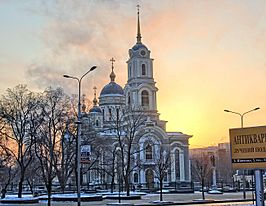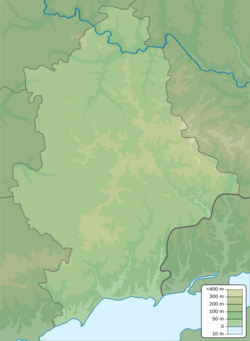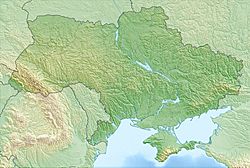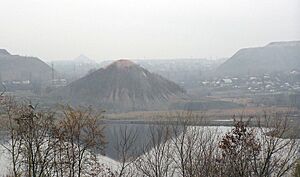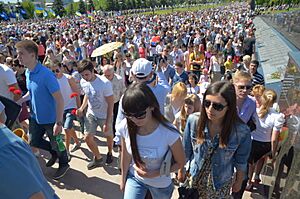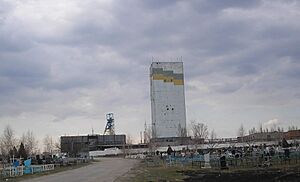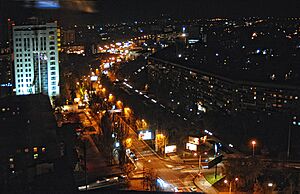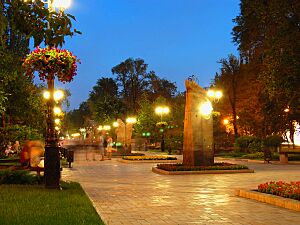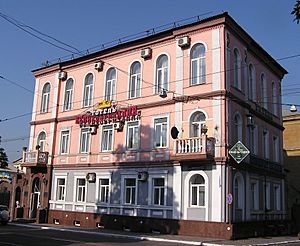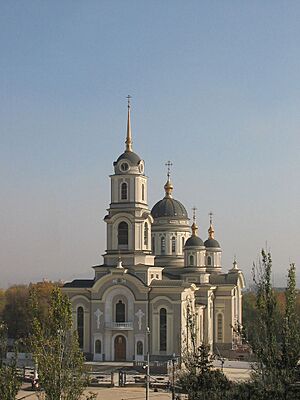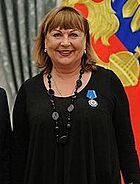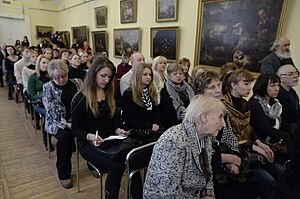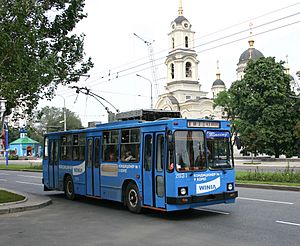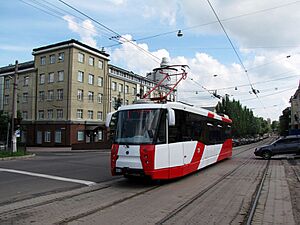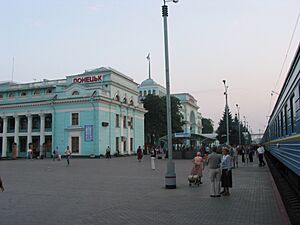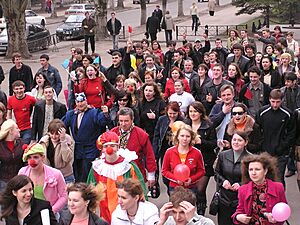Donetsk facts for kids
Quick facts for kids
Donetsk
|
|||
|---|---|---|---|
|
City
|
|||
| Ukrainian transcription(s) | |||
| • Romanization | Donetsk | ||
| • Scholarly | Doneck | ||
|
Left to right from top: Transfiguration Cathedral (big image); Donbass Palace; Drama Theatre; Lenin Square; Opera Theatre; and bridge on Ilicha Prospect
|
|||
|
|||
| Country | Ukraine (occupied by Russia) | ||
| Oblast | Donetsk Oblast | ||
| Raion | Donetsk Raion | ||
| Hromada | Donetsk urban hromada | ||
| Founded | 1869 | ||
| City rights | 1917 | ||
| Districts |
List of 9
Budionnivskyi District
Voroshylovskyi District Kalininskyi District Kyivskyi District Kirovskyi District Kuibyshevskyi District Leninskyi District Petrovskyi District Proletarskyi District |
||
| Area | |||
| • City | 358 km2 (138 sq mi) | ||
| • Metro | 2,895 km2 (1,118 sq mi) | ||
| Elevation | 169 m (554 ft) | ||
| Population
(2022)
|
|||
| • City | 901,645 | ||
| • Density | 2,519/km2 (6,523/sq mi) | ||
| • Metro | 1,560,000 | ||
| Demonym(s) | Donechchany (Ukrainian: Донечча́ни) or Donchane (Russian: Донча́не) | ||
| Time zone | UTC+2 (EET) | ||
| • Summer (DST) | UTC+3 (EEST) | ||
| Postal code |
83000–83497
|
||
| Area code(s) | +380 622, 623 | ||
| Licence plate | АН | ||
| Sister cities | Bochum, Charleroi, Kutaisi, Pittsburgh, Sheffield, Taranto, Moscow, Vilnius | ||
| Climate | Dfb | ||
| Website | (Russian city occupational administration) | ||
| Donetsk was founded in 1869 as a workers' settlement Yuzovka/Yuzivka around the metallurgical factory of the Welshman John Hughes. The settlement was established in lands of Yevdokim Shydlovsky, who received them upon destruction of the Zaporizhian Sich in 1775. The population of the metropolitan area is from 2004. |
|||
Donetsk is a big industrial city in eastern Ukraine. It sits on the Kalmius River in Donetsk Oblast. The city is currently controlled by Russia and is seen as the capital of the Donetsk People's Republic.
Donetsk has had several names over time, including Aleksandrovka, Yuzivka (or Hughesovka), Stalin, and Stalino. In 2022, about 901,645 people lived in the city. Over 2 million people live in the wider metropolitan area. In 2001, Donetsk was the fifth-largest city in Ukraine.
Donetsk is known as the unofficial capital of the larger Donets Basin (Donbas) region. It's next to another big city, Makiivka. Together with other nearby cities, they form a large urban area. Donetsk is a major center for business, industry, and science in Ukraine. It has many heavy industries, like steel production, chemical factories, and coal mining. These industries have made the city's environment a bit challenging.
The first settlement in this area was called Aleksandrovka in 1779. In 1869, a Welsh businessman named John Hughes started a steel plant and coal mines here. The town was then named Hughesovka or Yuzovka after him. During the Soviet era, the steel industry grew. In 1924, Yuzovka was renamed Stalin, then Stalino in 1929. In 1961, it was renamed Donetsk. Today, it's still a key place for coal mining and the steel industry.
Since April 2014, Donetsk has been a major battleground in the Russo-Ukrainian War. Pro-Russian groups have been fighting Ukrainian forces for control. The city of Donetsk is run by these pro-Russian groups as the center of the Donetsk People's Republic. The Donetsk International Airport saw heavy fighting for almost a year in 2014. As of October 2022, Russia controls the city, but fighting continues nearby.
History of Donetsk
How Donetsk Started
One of the first mining settlements in the Donetsk area was called Oleksandrivka. Records show a Cossack settlement called Oleksandrivska existed there by 1779. Later, the Oleksandrivska coal mine opened in this spot.
The city of Donetsk was officially started in 1869 by Welsh businessman John Hughes. He built a steel plant and several coal mines near Oleksandrivka. The workers' village around the plant joined with Oleksandrivka. This new place was named Yuzovka, after Hughes. Many immigrants from Wales, especially from Merthyr Tydfil, moved here. By the early 1900s, Yuzovka had about 50,000 people. It became a city in 1917. The "English Colony" was the main part of Yuzovka, and its buildings show its British roots.
Donetsk in Soviet Times

During the Russian Civil War, Yuzivka became part of the Ukrainian People's Republic. It was briefly captured by Bolshevik forces in January 1918 but then taken back by Ukraine. Soviet forces captured it again later.
In 1924, under Soviet rule, the city's name changed to Stalin. In 1929, it was renamed Stalino. By 1931, the city got its first drinking water system. In July 1933, Stalino became the main city of the Donetsk Oblast. The city was briefly called Trotsk in late 1923, after Leon Trotsky.
Before World War II, Stalino had 507,000 people. The war, especially the invasion by Nazi Germany, badly damaged the city. It was occupied by German and Italian forces from October 1941 to September 1943. After the war, the city was largely rebuilt.
In 1945, many young people from Yugoslavia, Hungary, and Romania were sent to Russia. They were forced to work as laborers to rebuild Stalino and work in its mines. Conditions were very tough, and many died from illness and hunger.
In November 1961, during a period of destalinization, the city was renamed Donetsk. This new name came from the Seversky Donets River, which is a branch of the Don River. This change was made to move away from the name of former leader Joseph Stalin.
In 1965, the Donetsk Academy of Sciences was created.
Donetsk in Independent Ukraine
After Ukraine declared independence on August 24, 1991, a vote was held on December 1, 1991. In Donetsk, 83.90% of voters chose independence.
In the 1990s, Donetsk faced challenges. But it quickly modernized, thanks to large companies. In 1994, a vote in Donetsk and Luhansk regions showed strong support for making Russian an official language alongside Ukrainian.
Many coal mine accidents happened in Donetsk and the region during the 1990s and 2000s. This included major disasters in 2007, 2008, and 2015. One reason for these accidents was linking miners' pay to how much coal they produced. This encouraged ignoring safety rules that slowed down work.
In 2008, Donetsk was named the best city in the Commonwealth of Independent States for its development plans. In 2012 and 2013, it was recognized as the best place for business in Ukraine.
Donetsk from 2014 to Today
After President Viktor Yanukovych left Ukraine in 2014, pro-Russian groups took over the main government building in Donetsk. The police did not stop them. Donetsk became a key area for the 2014 pro-Russian unrest in Ukraine.
On April 7, 2014, pro-Russian activists declared the "Donetsk People's Republic" and asked for Russia's help. On May 11, 2014, a vote on self-rule was held in Donetsk. The election commission said almost 90 percent of voters supported independence from Kyiv. Ukraine, the EU, and the US do not recognize this vote as legal.
Heavy fighting has caused civilian deaths in Donetsk. Human Rights Watch has asked both sides to stop using unguided missiles in populated areas. They said using these weapons could be a war crime.
On September 30, 2022, Russian President Vladimir Putin signed a document claiming to add Donetsk and three other regions to Russia. Most countries see this as a violation of international law.
Geography and Climate
Where is Donetsk?
Donetsk is in a steppe area, which is a large flat grassland. It has some scattered forests, hills, and spoil tips (piles of waste from mining). The Kalmius River connects the city to the Sea of Azov, which is about 95 kilometers (59 miles) south. The Sea of Azov is a popular place for people from Donetsk to relax. Farmlands surround the city.
The city stretches 28 kilometers (17 miles) from north to south and 55 kilometers (34 miles) from east to west. There are two nearby reservoirs: Nyzhnekalmius and the Donetsk Sea. Five rivers flow through the city, including the Kalmius. The city also has 125 spoil tips.
Donetsk Weather
Donetsk has a moderate hot summer continental climate. This means it has warm summers and cold winters. The average temperature in January is -4.1°C (24.6°F). In July, the average temperature is 21.6°C (70.9°F). The city gets about 556 millimeters (21.9 inches) of rain each year, spread over about 162 days.
| Climate data for Donetsk (1991–2020) | |||||||||||||
|---|---|---|---|---|---|---|---|---|---|---|---|---|---|
| Month | Jan | Feb | Mar | Apr | May | Jun | Jul | Aug | Sep | Oct | Nov | Dec | Year |
| Record high °C (°F) | 12.8 (55.0) |
16.0 (60.8) |
23.8 (74.8) |
31.0 (87.8) |
34.6 (94.3) |
35.8 (96.4) |
37.8 (100.0) |
39.1 (102.4) |
33.9 (93.0) |
32.7 (90.9) |
20.3 (68.5) |
15.0 (59.0) |
39.1 (102.4) |
| Mean daily maximum °C (°F) | −1.2 (29.8) |
−0.4 (31.3) |
6.1 (43.0) |
15.0 (59.0) |
21.5 (70.7) |
25.7 (78.3) |
28.5 (83.3) |
27.9 (82.2) |
21.4 (70.5) |
13.4 (56.1) |
5.2 (41.4) |
0.0 (32.0) |
13.6 (56.5) |
| Daily mean °C (°F) | −4.0 (24.8) |
−3.5 (25.7) |
2.0 (35.6) |
9.8 (49.6) |
15.9 (60.6) |
20.1 (68.2) |
22.5 (72.5) |
21.8 (71.2) |
15.7 (60.3) |
8.9 (48.0) |
2.1 (35.8) |
−2.5 (27.5) |
9.1 (48.3) |
| Mean daily minimum °C (°F) | −6.5 (20.3) |
−6.4 (20.5) |
−1.6 (29.1) |
5.0 (41.0) |
10.3 (50.5) |
14.5 (58.1) |
16.7 (62.1) |
15.9 (60.6) |
10.6 (51.1) |
5.0 (41.0) |
−0.6 (30.9) |
−4.9 (23.2) |
4.8 (40.7) |
| Record low °C (°F) | −33.5 (−28.3) |
−31.1 (−24.0) |
−24.8 (−12.6) |
−10.6 (12.9) |
−4.4 (24.1) |
2.1 (35.8) |
5.8 (42.4) |
2.0 (35.6) |
−6.0 (21.2) |
−10.3 (13.5) |
−22.7 (−8.9) |
−28.5 (−19.3) |
−33.5 (−28.3) |
| Average precipitation mm (inches) | 38 (1.5) |
31 (1.2) |
37 (1.5) |
38 (1.5) |
50 (2.0) |
65 (2.6) |
52 (2.0) |
40 (1.6) |
43 (1.7) |
41 (1.6) |
37 (1.5) |
44 (1.7) |
516 (20.4) |
| Average rainy days | 11 | 8 | 10 | 13 | 13 | 14 | 11 | 8 | 11 | 11 | 13 | 11 | 134 |
| Average snowy days | 17 | 17 | 10 | 2 | 0 | 0 | 0 | 0 | 0 | 2 | 8 | 16 | 7 |
| Average relative humidity (%) | 86.8 | 83.7 | 77.3 | 65.6 | 62.0 | 65.7 | 63.8 | 60.2 | 67.0 | 75.9 | 85.7 | 87.8 | 73.5 |
| Source 1: Pogoda.ru.net | |||||||||||||
| Source 2: NOAA (humidity 1981-2010) | |||||||||||||
People of Donetsk
| Historical population | ||
|---|---|---|
| Year | Pop. | ±% |
| 1897 | 28,100 | — |
| 1926 | 105,739 | +276.3% |
| 1939 | 466,268 | +341.0% |
| 1959 | 704,821 | +51.2% |
| 1970 | 878,590 | +24.7% |
| 1979 | 1,020,799 | +16.2% |
| 1989 | 1,109,102 | +8.7% |
| 2001 | 1,016,194 | −8.4% |
| 2011 | 962,049 | −5.3% |
| 2022 | 901,645 | −6.3% |
In 2009, Donetsk had over 985,000 people. The wider metropolitan area had over 1.5 million people in 2004. It was the fifth-largest city in Ukraine.
Most people in Donetsk speak Russian (87.8%) as their native language. About 11.1% speak Ukrainian.
The main ethnic groups in Donetsk, based on the 2001 census, are:
- Russians: 48.15%
- Ukrainians: 46.65%
- Belarusians: 1.15%
- Pontic Greeks: 0.99%
- Jews: 0.50%
- Tatars: 0.49%
- Armenians: 0.40%
- Other groups make up the rest.
Economy of Donetsk
Donetsk and its surrounding areas are very industrial. Many people work in heavy industry, especially coal mining. The city is a key center for heavy industry and coal mines in the Donets Basin (Donbas). There are coal mines directly under the city. Sadly, there have been many mining accidents, like the one at the Zasyadko mine that killed over 100 workers.
Donetsk's economy includes about 200 industrial companies. These companies produce goods worth over 120 billion rubles each year. There are also more than 20,000 small and medium-sized businesses. The city has 17 coal mines, 5 large metal factories, 67 engineering companies, and 32 food industry businesses.
After the Soviet Union ended, Donetsk and other cities in Donbas faced tough times. Many factories closed, and people lost their jobs.
Donetsk also has a "Donetsk" special economic zone. This is a special area where businesses get benefits to encourage growth. In 2012, Forbes magazine named Donetsk the best city for business in Ukraine. It scored high in areas like skilled workers, people's buying power, investment opportunities, and good infrastructure.
A popular shopping area in the city is the Donetsk City mall.
Sports in Donetsk
Donetsk is a big sports city. It has good facilities and has hosted international events like the Davis Cup and UEFA Champions League. The city is known for football, hockey, basketball, boxing, tennis, and athletics.
Football
Football is the most popular sport in Donetsk. The city has two main professional football clubs: Shakhtar Donetsk and FC Olimpik Donetsk. Shakhtar Donetsk used to play at the Donbas Arena. They have won the Ukrainian Championship and Ukrainian Cup many times. In 2009, they won the UEFA Cup, becoming the second Ukrainian team to win a European competition.
The Donbas Arena stadium opened in 2009. It was the first stadium in Eastern Europe built to UEFA's "Elite" standards. Donetsk was chosen to host matches for the UEFA Euro 2012 tournament.
Other Sports
Donetsk is home to the ice hockey club HC Donbass. They won the 2011 Ukrainian Hockey Championship. They also won the 2012–13 IIHF Continental Cup in 2013.
The city also had a basketball club, BC Donetsk, which won the 2012 Ukrainian championship. Donetsk was supposed to host games for the FIBA EuroBasket 2015 tournament. However, due to the ongoing war, the club stopped playing, and the tournament was moved.
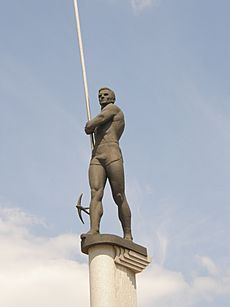
Donetsk has always been important for athletics. It hosted many events, including Soviet Athletics Championships. The city is especially famous for pole vaulting. Serhii Bubka, a legendary pole vaulter, grew up in Donetsk. He started an annual pole vaulting event called Pole Vault Stars in the city in 1992. Bubka set world indoor records at this event three times. His indoor world record of 6.15 meters (20.18 feet) set in 1993 was not broken until 2014.
Professional Sports Teams
Here is a list of professional sports teams from Donetsk. Due to the Russo-Ukrainian War, none of these clubs currently play in the city.
| Club | League | Sport | Venue | Established | Championships |
|---|---|---|---|---|---|
| FC Shakhtar Donetsk | Ukrainian Premier League | Association football | Donbas Arena/NSC Olimpiyskiy (Kyiv) | 1936 | 13 |
| FC Olimpik Donetsk | Ukrainian First League | Association football | Sports Complex Olimpik/Yunist Stadium (Chernihiv) | 2001 | 0 |
| WFC Donchanka (defunct) | Ukrainian Women's League | Women's association football | TsPOR Donchanka Stadium | 1992 | 5 |
| MFC Shakhtar Donetsk (defunct) | Ukrainian Futsal Championship | Futsal | Pavilion | 1998 | 5 |
| HC Donbas | Ukrainian Handball Super League | Handball | SC Tekstilshik/SC Dynamo (Zaporizhzhia) | 1983 | 3 |
| HC Donbass | Ukrainian Hockey League | Ice hockey | Druzhba Arena/Altair Arena (Druzhkivka) | 2005 | Ukraine: 4 (2 as affiliate HC Donbass-2) |
| BC Donetsk (defunct) | Ukrainian SuperLeague | Basketball | Druzhba Arena | 2006 | 1 |
| VC Shakhtar Donetsk (defunct) | Ukrainian Volleyball Championship | Volleyball | Druzhba Arena | 1983 | Soviet Union: 1 Ukraine: 2 |
Culture and Attractions
Main Sights in Donetsk
Artema Street: The Heart of Donetsk
Artema Street, also known as First Line Avenue, is considered the main street in Donetsk. It's a great place to start exploring the city. You'll find a mix of old and new buildings, small parks, hotels, shops, and restaurants. Important places here include Lenin Square, the Opera & Ballet Theatre, and the Donetsk Drama Theatre.
Statue of Artyom
This six-meter-tall (20-foot-tall) statue on Artema Street honors Soviet politician Fyodor Sergeyev.
Donetsk Opera and Ballet Theatre
Built in 1936, the Donetsk State Academic Opera and Ballet Theatre has been home to the Donetsk Ballet company since 1946.
Donbas Palace Hotel
This 5-star hotel is in the center of Donetsk. It was built in 1938. During the Nazi occupation, the Gestapo used it as their headquarters. The hotel was partly destroyed during the war but reopened in 2004 after being rebuilt.
Pushkin Boulevard
This is a 2-kilometer-long (1.2-mile) green walkway. It has fountains, cafes, and statues, like the one honoring Taras Shevchenko. The Mertsalov Palm sculpture is also here. It was made in 1896 by a local blacksmith, Aleksei Mertsalov, from a single rail. It showed the amazing skills of the local industry.
Monument to John Hughes
This statue, built in 2001, is in front of Donetsk National Technical University. It honors John James Hughes, the Welsh founder of the city. He built the Yuzovka Steel Plant, which started Donetsk's industrial history.
Forged Figures Park
This park opened in 2001. Every year, the International Smithcraft Festival takes place here. Some of the winning artworks are given to the city and stay in the park, adding to its collection of sculptures.
Aqua Park
Donetsk Aquapark "Royal Marine" opened in Scherbakova Park in late 2012. It has a large dome that can open up to let in sunlight. This aqua park is one of the biggest indoor water parks in the world.
City Design and Buildings
When Donetsk was called Yuzovka, it was split into two parts. The southern part had factories, railway stations, hospitals, and schools. Near the factories was the "English colony," where engineers and managers lived. Many buildings in the southern part were built in the English style. They had rectangular and triangular fronts, green roofs, and large windows.
In the northern part of Yuzovka, called Novyi Svet, lived traders, craftspeople, and government workers. This area had the market, police headquarters, and the Transfiguration Cathedral. The main streets here had one or two-story buildings, markets, restaurants, hotels, and banks. The Hotel Great Britain is a famous old building still standing in this area.
After World War II, much of the city was rebuilt. Many buildings from the second half of the 20th century were designed by architect Pavel Vigdergauz.
Religions in Donetsk
People in Donetsk follow different religions. These include various branches of the Eastern Orthodox Church, Eastern Catholic Churches, Protestantism, and the Roman Catholic Church. There are also followers of Islam and Judaism.
Media in Donetsk
Five television stations operate in Donetsk:
- TRK Ukraina
- KRT, Kyivska Rus'
- First Municipal
- Kanal 27
- TRK Donbass
Donetsk also has a 360-meter (1,180-foot) tall TV tower, which was finished in 1992. It is one of the tallest structures in the city.
Famous People from Donetsk


People from Donetsk are often called Donchyani. Many famous people were born or grew up in the city:
- Rinat Akhmetov (born 1966), a Ukrainian billionaire businessman.
- Emma Andijewska (born 1931), a modern Ukrainian poet, writer, and painter.
- Nikita Khrushchev (1894–1971), who was the leader of the Soviet Union from 1953 to 1964, grew up in Yuzovka.
- Tatyana Kravchenko (born 1953), a Soviet and Russian actress.
- Siouzana Melikián (born 1986), a Russian-Mexican actress.
- Natan Sharansky (born 1948), an Israeli politician and writer.
- Anatoliy Solovianenko (1932–1999), a famous Soviet opera singer.
- Vasyl Stus (1938–1985), a Ukrainian poet and activist.
- Viktor Yanukovych (born 1950), a former president of Ukraine.

Famous Athletes from Donetsk
- Polina Astakhova (1936–2005), a Ukrainian gymnast and Olympic medalist.
- Serhii Bubka (born 1963), a Ukrainian pole vault athlete who won a gold medal at the 1988 Summer Olympics.
- Lilia Podkopayeva (born 1978), a Ukrainian gymnast and the 1996 Olympic All-Around Champion.
- Nadiya Tkachenko (born 1948), an Olympic gold-winning pentathlete.
- Oleg Verniaiev (born 1993), a gymnast who won an Olympic gold medal.
Museums in Donetsk
Donetsk has about 140 museums. Two large regional museums are the Donetsk Region History Museum and the Donetsk Regional Art Museum.
The Donetsk Region History Museum tells the story of the city and its people. It opened in 1924 and has 120,000 items. These range from ancient archaeological finds to the city's founding by John Hughes, its industrial growth, World War II, and the Soviet era. On August 21, 2014, the museum's roof and walls were damaged by shelling.
The FC Shaktar Museum opened in 2010. It was the first Ukrainian museum to be nominated for a European Museum of the Year Award.
Transportation in Donetsk
Getting Around the City
The main ways to get around Donetsk are by trams, electric trolley buses, buses, and marshrutkas (private minibuses). The city's public transport is run by the Dongorpastrans company. Donetsk has 12 tram lines, 17 trolley bus lines, and about 115 bus lines. There are also 32 taxicab services.
The city has several railway stations for local travel: Yuzhny (South), Tsentr (Centre), Krytyi rynok (Indoor market), and Putilovsky.
Construction of a metro (subway) system began in 1992 but stopped in 2012 because there wasn't enough money. No lines or stations were ever finished.
Train Travel
Donetsk's main railway station is in the northern part of the city. In the early 2000s, it served about 7 million passengers each year. There is a museum near the main station that shows the history of the region's railways. The Donetsk Railways, based in Donetsk, was the largest railway system in the region.
Roads
The ![]() highway, which is part of a larger European road network, goes through Donetsk. Another international road, the M 04, also passes through the city. Several national Ukrainian roads also run through Donetsk.
highway, which is part of a larger European road network, goes through Donetsk. Another international road, the M 04, also passes through the city. Several national Ukrainian roads also run through Donetsk.
Air Travel
Donetsk used to have an international airport. It was built in the 1940s and 1950s and rebuilt in 1973 and again from 2011 to 2012. However, due to fighting, the airport closed on May 26, 2014, and has been largely destroyed. The airspace over Donetsk has also been closed since the MH17 disaster.
Education in Donetsk
Donetsk has many universities and educational institutions. These include five state universities, 11 institutes, three academies, 14 technical schools, five private universities, and six colleges.
The most important schools are Donetsk National Technical University, founded in 1921, and the Donetsk National University, founded in 1937. Donetsk is also home to the Donetsk National Medical University, which started in 1930 and became one of the largest medical universities in the Soviet Union. There are also several research institutes and an Islamic University.
Donetsk also has the Prokofiev Donetsk State Music Academy, a music school founded in 1960.
Sister Cities
Donetsk has "sister city" relationships with other cities around the world. These partnerships help cities share culture and ideas.
 Baku, Azerbaijan (2009)
Baku, Azerbaijan (2009) Bochum, Germany (1987)
Bochum, Germany (1987) Charleroi, Belgium
Charleroi, Belgium Katowice, Poland
Katowice, Poland Kutaisi, Georgia
Kutaisi, Georgia Matagalpa, Nicaragua (2004)
Matagalpa, Nicaragua (2004) Pittsburgh, United States
Pittsburgh, United States Sheffield, United Kingdom
Sheffield, United Kingdom Taranto, Italy (1984)
Taranto, Italy (1984) Vilnius, Lithuania
Vilnius, Lithuania
Images for kids
See also
 In Spanish: Donetsk para niños
In Spanish: Donetsk para niños


